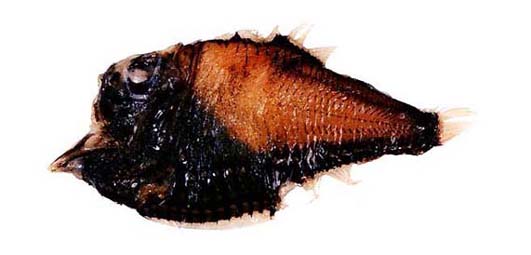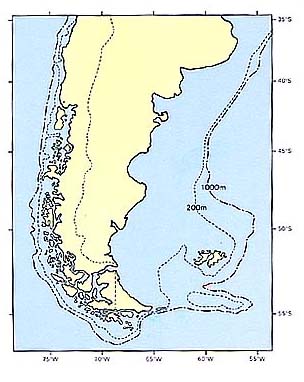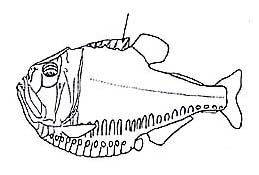ムネエソ科
- HOME
- デジタル図鑑
- パタゴニア海域の重要水族
- 硬骨魚綱 ワニトカゲギス目 ムネエソ科
ムネエソ科(Sternoptychidae)

16 オオホウネンエソ(Oo-hooneneso)
Argyropelecus gigas Norman, 1930
特 徴:
背鰭9軟条,臀鰭13軟条,胸鰭7軟条,鰓耙数8+1+10。体長に対する体高の割合は53.6%,頭長は29.9%,眼径は5.8%,両眼間隔は2.5%,吻長は9.0%,上顎長は24.9%,胸鰭長は20.8%,腹鰭長は4.8%。体は著しく側扁し,体高は高い。口はほぼ垂直に開く。両顎には微小歯が1列に並び,先端のものは犬歯状。前鰓蓋骨の棘は強く長く,下方に向い,その上方には前後両方に向う棘を有する瘤状物がある。頭部背面に骨質の隆起縁が発達する。背鰭がある。体側下方の発光器は細長くて明瞭。胸鰭から臀鰭後端上部に至る発光器は特に細長くて大きく,その数は20個。腹部発光器は峡部から腹鰭基底に連なり,むしろ丸く,その数は13個。下顎後方に6個,鰓蓋骨後下縁から胸鰭基底にかけて6個の発光器がある。腹部発光器下の腹縁に半透明の隆起縁が発達する。保存標本では,体の背面は黒褐色,腹面の発光器の周辺は漆黒色で,発光器の上方は黄白色,中央は青黒色,頭部は黒色。
分 布:
大西洋の外洋深海域(Norman, 1930)。アルゼンチンからはフォークランド諸島の南斜面の深海域(1,000m)から1個体採集された。
備 考:
近縁のA. affinisとは体形及び背刀の高さにより区別される。本種は体長が体高の1 4/5から2倍で背刀が高いのに対し,A. affinisは2 1/4から2 3/1倍で背刀の高さは低い(Schultz, 1960)。最大体長87mm。
(稲田伊史)
Material examined:
1 from Argentina (85.7 mm SL), FSFL EM 383.
Description:
D 9; A 13; P110; P2 7; GR 8+1+10=19.
HL 29.9% of SL; ED 5.8; BD 53.6; SN 9.0; IO 2.5; UJ 24.9; P1L 20.8; P2L 4.8.
Body deep and extremely compressed; body depth 1.9 in SL. Mouth large and vertical. Posteriorly located teeth on maxilla pointed forward. Upper preopercular spine well developed. Short post-abdominal spine present. Supra-abdominal, preanal, anal and subcaudal groups of photophores nearly in a straight and continuous line; abdominal photophores 13; supra-abdominal + preanal + anal + subcaudal photophores 20; dorsal blade present and well developed in front of dorsal fin. Abdominal margin under supra-abdominal photophores keeled and semi-translucent. Formalin fixed specimen brownish black dorsally, pure black ventrally; upper part of photophores yellowish white, middle part bluish black.
Distribution:
Argentine Patagonia, found only in the Atlantic (Schultz, 1964), mesopelagic (Norman, 1930).
Remarks:
Distinguished from the closely related species. A. Affinis Garman, 1899 by the following characters: A. affinis has a rather slender body (body depth 2 1/4 to 2 1/3), dorsal blade lower than that of A. gigas (Schultz, 1964). It is somewhat curious that any fishes of Sternoptychidae have not been recorded from the waters off Argentina so far (Norman, 1937a; Ringuelet and Aramburu, 1960; Menni, Ringuelet and Aramburu, 1984). So, this is the first record of Argyropelecus gigas simultaneously as well as the family Sternoptychidae to the Argentine ichthyofauna. However, the eastern South Pacific survey by R/V Anton Brunn recorded 6 species of Argyropelecus; A. gigas, A. aculeatus, A. affinis, A. hemigymnus, A. sladeni, and A. olfersi (Craddock and Mead, 1970).
(Tadashi INADA)

Distribution of Argyropelecus gigas in Patagonia.

External feature. Dorsal blade arrowed.
- 1
- 2